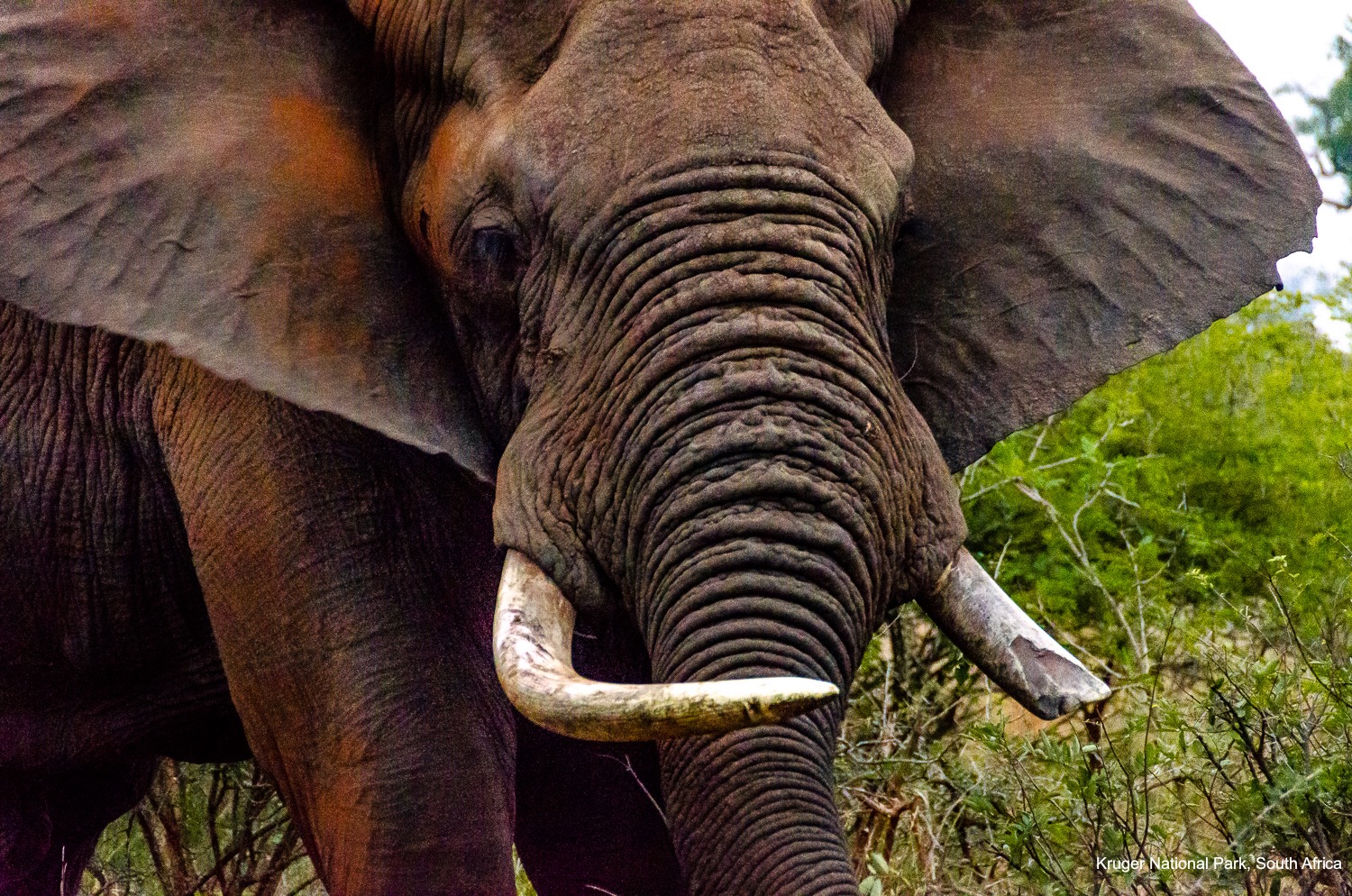South Africa is an incredible country with a diverse population, rugged landscapes, ocean coasts, and extensive wildlife. It also continues to have volatile politics and remains the economic engine for the southern tip of the continent. While it often dominates the headlines for the region, in-the-east Mozambique, Eswatini (formerly Swaziland) and Lesotho are neighbors, each with their own vibrant culture and complex history. One of the great African road trips is visiting these four countries in one’s vehicle, seeing the unfolding of the scenery, and interacting with local folks.
This two-week trip in July of 2022 started in Johannesburg, then proceeded to Kruger National Park, Maputo the capital of Mozambique, Eswatini, Durban South Africa, Lesotho, Clarens South Africa and back to Johannesburg. Be sure to see South African Road Trip – Part 2: Eswatini, Durban, Lesotho and Clarens.
Where Are These Countries?
They are in the southeast tip of Africa, bordering Botswana and Zimbabwe. Eswatini and Lesotho are landlocked, the former between Mozambique and South Africa and the latter surrounded by South Africa.
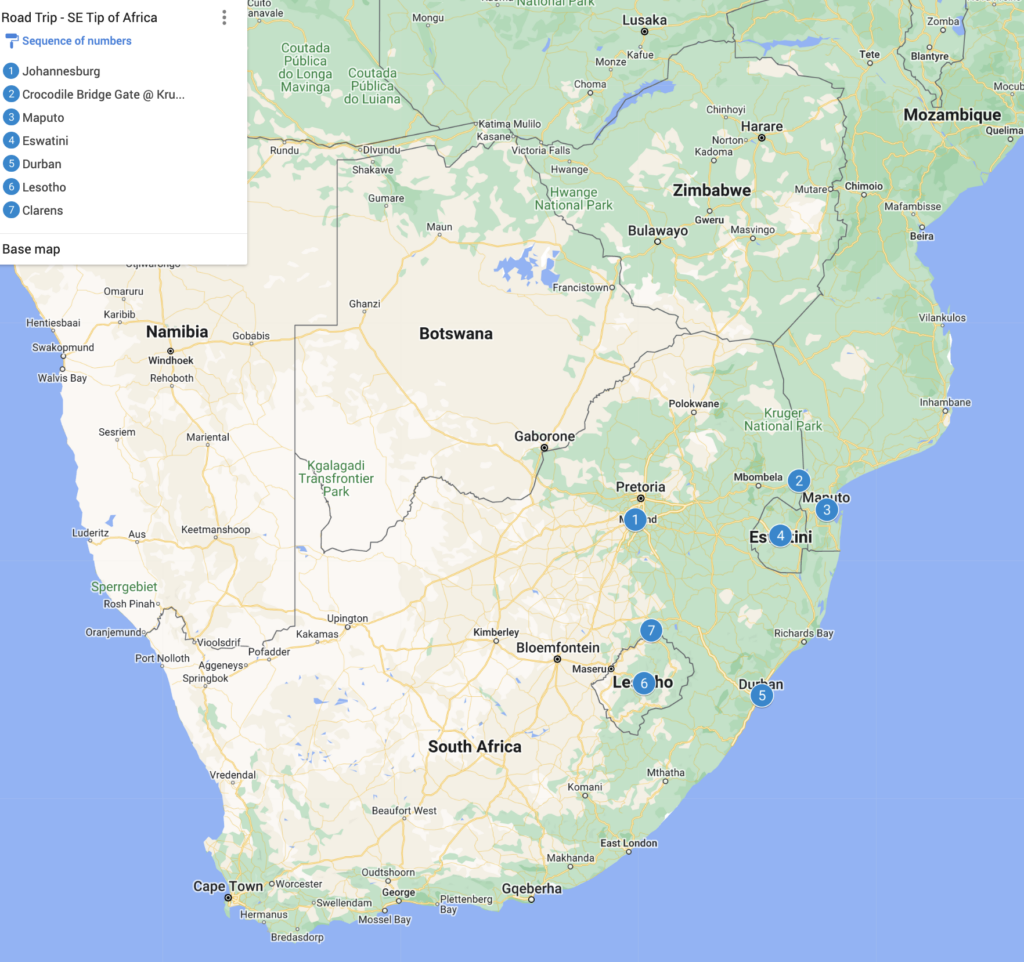
Why We Went to Southern Africa
My wife Khadija and I had this trip planned in 2020 but had to cancel because of Covid travel restrictions. Almost as soon as we were allowed, in July 2022, we jumped on the opportunity and quickly arranged it, as we had both been in the country of South Africa only a day and hadn’t been to the others.
How Long to Spend in South Africa and Neighboring Countries?
For our route, we spent two weeks which was adequate, but we easily could have spent twice that, especially if we went hiking in the mountains or took a more leisurely pace.
Are South Africa and Neighboring Countries Safe?
The big cities of South Africa are not known as safe. While in Johannesburg and Durban, we were invariably told to watch out. It’s hard to judge whether this was an excess of caution or justified. We rented a car and drove for two weeks in South Africa and neighboring countries and had no safety issues.
Maputo was very safe, and we walked the streets late at night. Lesotho and Eswatini didn’t seem to have safety concerns. Of course, it’s important to use common sense and avoid potentially risky situations, especially in an environment you aren’t unfamiliar with.
Are South Africa and Neighboring Countries Expensive?
We were there when the US dollar was strong and food and lodging were not expensive. South Africa and Mozambique roughly cost the same for travel and are more expensive than the other two countries.
Where to Stay in South Africa and Neighboring Countries.
Each location had all levels of accommodations.
An important decision is whether to stay in a luxury lodge in Kruger National Park. Here you can easily spend $500 / night or more, but you are mostly paying for excellent access to a wide variety of wildlife. It’s such a memorable experience and we found it worthwhile if you can afford it.
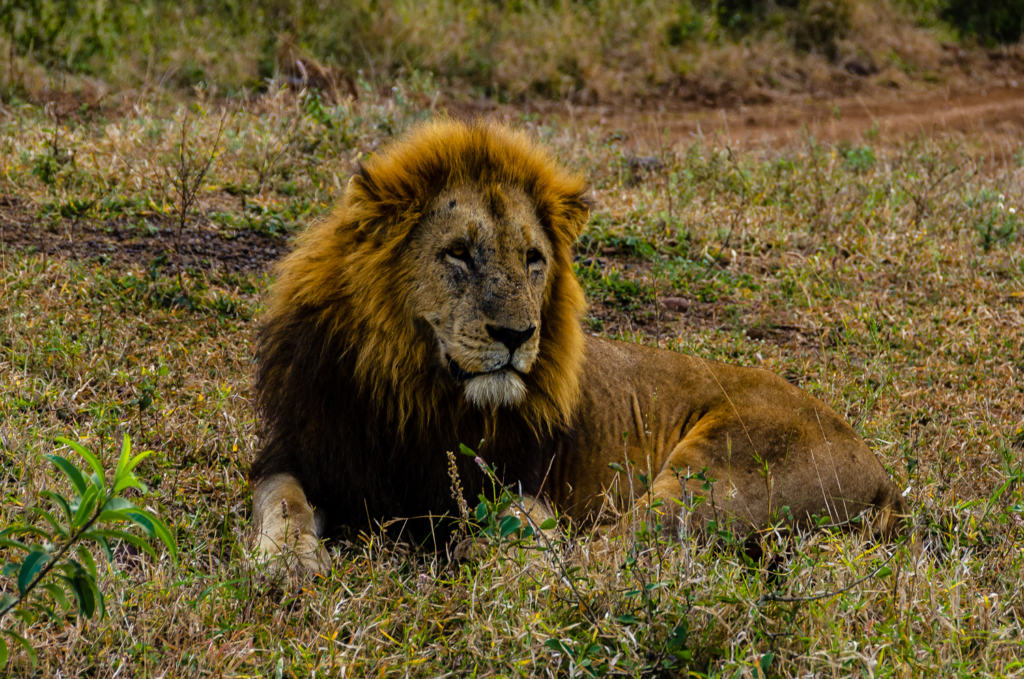
However, you can drive through Kruger for a day, strictly staying on the designated roads which limits what you would see, for about $7/person.
How to Get Around South Africa
We rented a compact car from Hertz in South Africa and thought it would be adequate because we were told the roads were good where we were going. However, there were periodic rough roads, including most of Lesotho’s, that we should have taken an SUV.
In this part of the world, it’s typical to tip the person pumping gas for you.
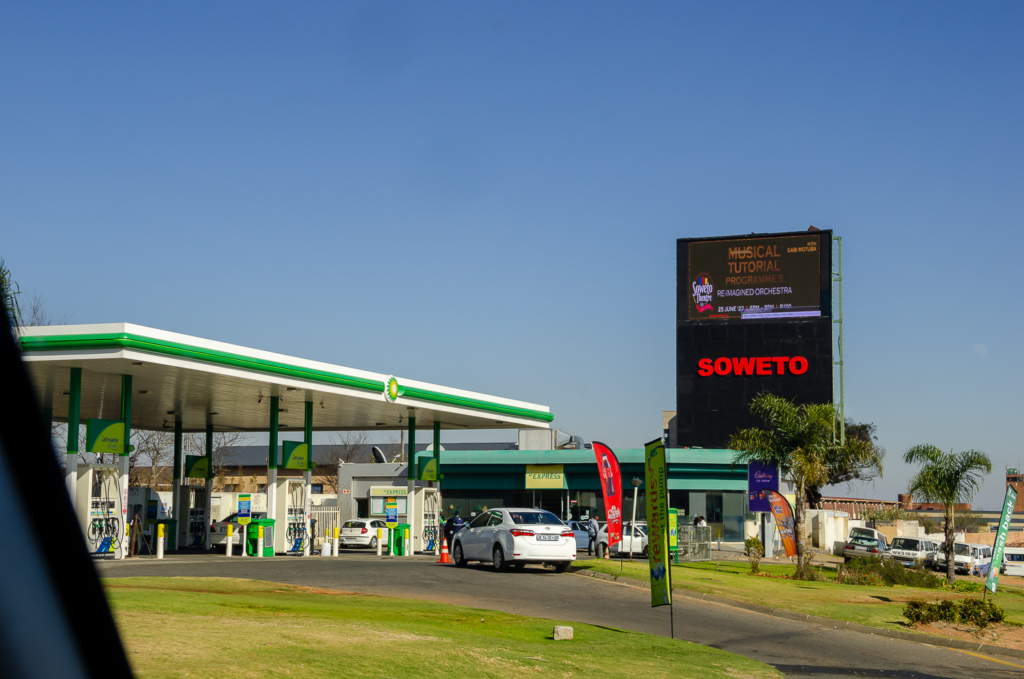
Dealing with Hertz was a dreadful experience. After we returned the car, they outrageously charged ZAR 50,000 ($3,300) for unspecified damage without giving an itemization of the charges. The rounded number indicated they were just pulling it out of thin air. There was nothing wrong with the operation of the car and we saw no obvious damage to the body. I contested the bill through the credit card company. The company initially reversed it but reinstated it because the South African correspondent bank said Hertz had contractual rights to make it. I disputed again through a written letter but they did not reverse the charges. I called Hertz International and after asking them several times, they reluctantly agreed to contact the Johannesburg office.
This was extremely frustrating. Part of the reason I rented from Hertz was I thought it would be much less likely for them to participate in unethical behavior. This experience is making me think that I should purchase zero deductible insurance from car rental companies in the future, even though it’s often expensive, to avoid a mess like this.
After another two months of waiting, Hertz gave me a full refund because there was a “billing error.” This probably happened because they had no documentation of what the charges were. Also my dogged pursuit and, I would like to think, my persuasive letters also helped.
What Languages Are Spoken in South Africa and Mozambique?
South Africans speak over 30 languages with Zulu being the first language for about a quarter of the population and was especially prevalent where we were. English is the language of government, commerce and media; used in the hospitality industry and widely spoken with some proficiency in urban areas.
Mozambicans speak Portuguese and local languages, but English isn’t common.
Soweto
We stayed over two days in Johannesburg but mainly visited the township of Soweto. We had a hotel room in Rosebank, a suburb north of Johannesburg, and walked around a little bit in the nearby malls and drove around. Besides that, we took a full-day tour of Soweto with Barney Smith of Funtime Tours (WhatsApp 0832526879). On the way to Soweto, we passed by Nelson Mandela’s last house.
Soweto is the biggest township in the country and an important center that revolted against apartheid. It was created as a “township” in the 1930s separating Blacks from Whites. Usually, a township was separated from white areas by barriers such as a river, railway track, industrial area or highway.
Cooling Towers
The two colorfully painted cooling towers of a decommissioned, coal-fired power station are a prominent landmark in Soweto.
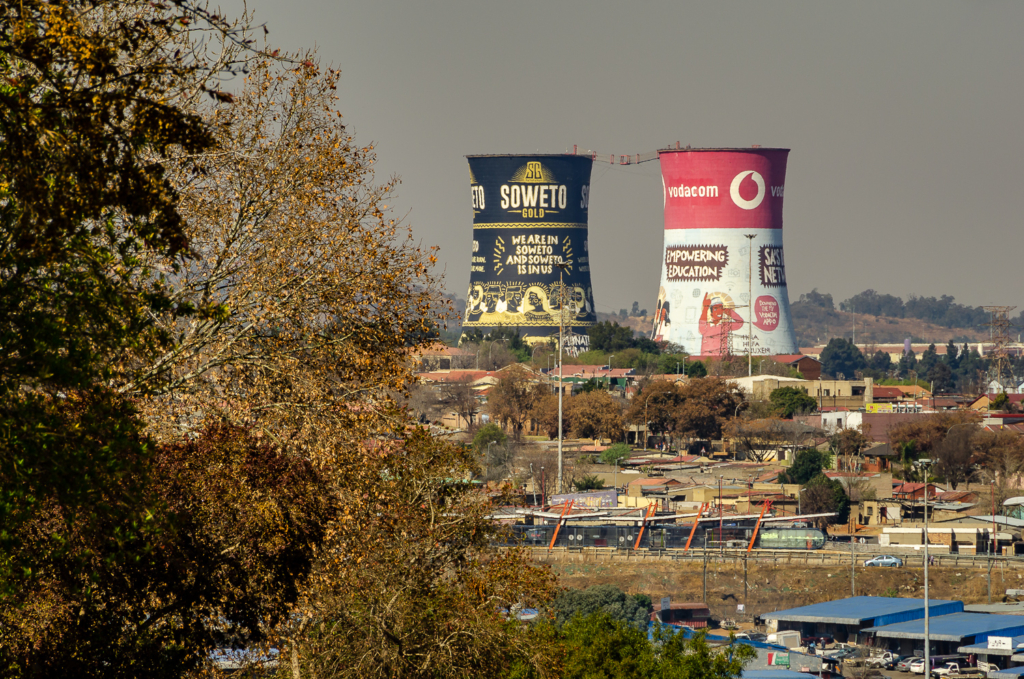
Matchbox House Neighborhoods
Many people in the townships originally lived in “matchbox” houses which were only one room and very cramped for families.
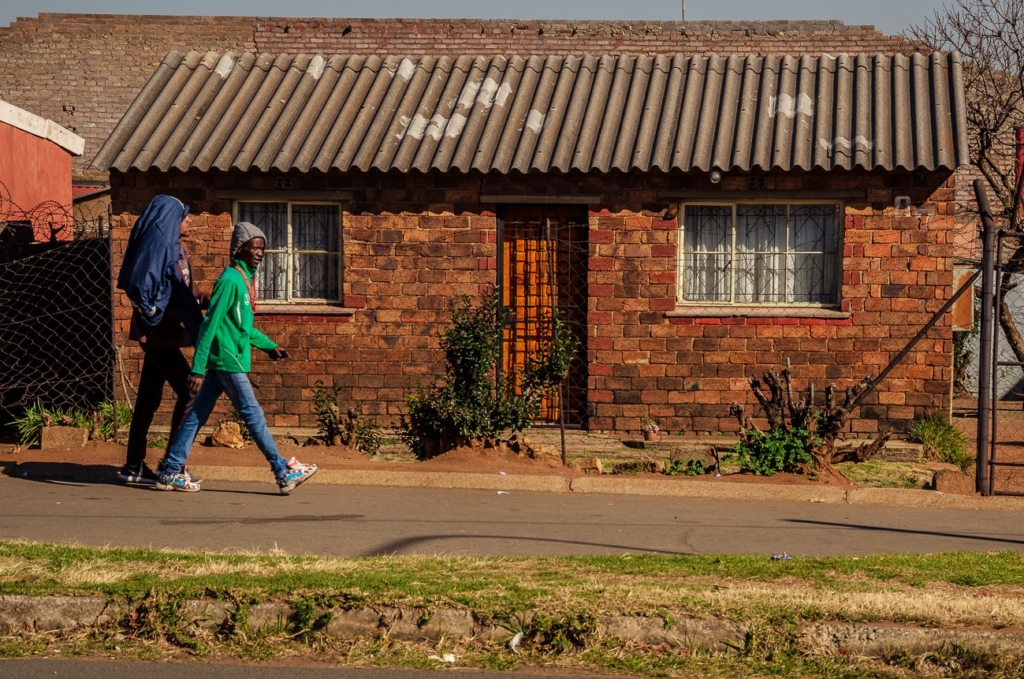
Some matchbox neighborhoods are impoverished, others are middle-class and have renovated and enlarged houses (a few to a McMansion size).
Shanty Towns
There are several makeshift shanty towns scattered around Soweto.

Some of the residents are illegal immigrants, others are those who have public housing, but rent it out to others.
Regina Mundi Roman Catholic Church
Regina Mundi (“Queen of the World”) is the largest Roman Catholic church in South Africa. Many demonstrators fled there in the 1976 demonstrations to the mandate that Afrikaans be the main language of instruction in school (the proverbial match that broke the camel’s back). The police entered the church and fired live ammunition. Some bullet holes are still visible. Upstairs there’s an exhibit of the apartheid era. Nelson Mandela has been elevated to saint or even savior status in South Africa, as shown on this stained glass.
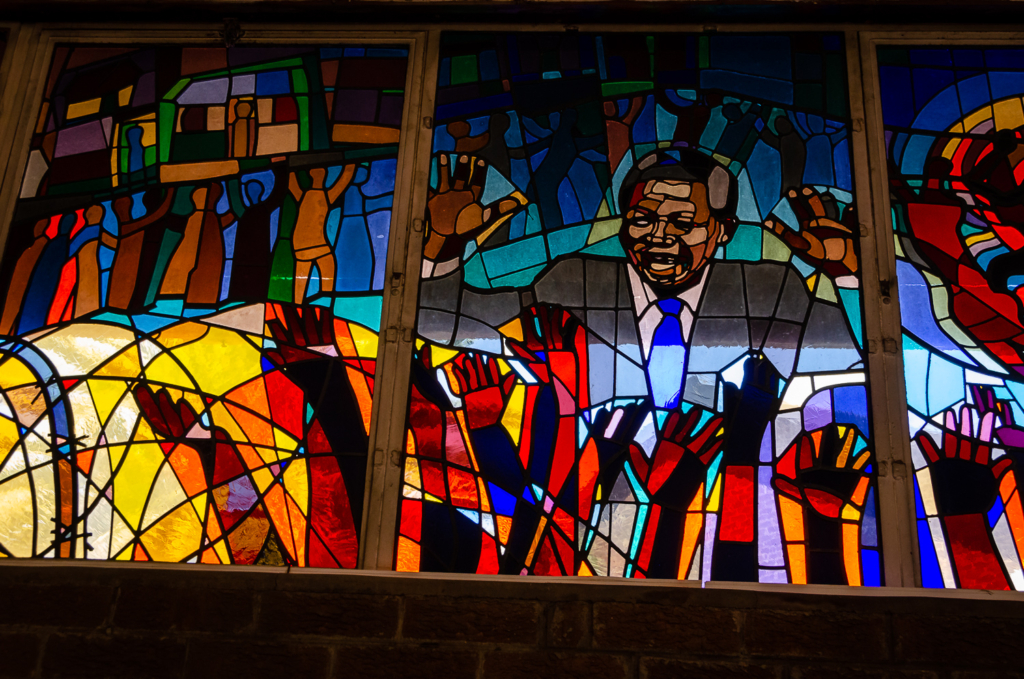
Nelson Mandela House Before Prison
We went to Nelson Mandela’s home on Vilakazi Street on the day of his birthday. He was born in 1918 and lived there in a matchbox house for 11 years before 27 years of imprisonment at age 44. Vilakazi is the only street in the world where two Nobel Peace Laureates lived (Mandela and Bishop Desmond Tutu). On the street were extremely fit performers dressed in traditional Zulu costumes.
Hector Pieterson Park
This is a memorial for Hector Pieterson, a South African schoolboy who was shot and killed at the age of 12 during the Soweto demonstrations. It has a simple but powerful inscription dedicating the memorial to Hector and others who died in the struggle.
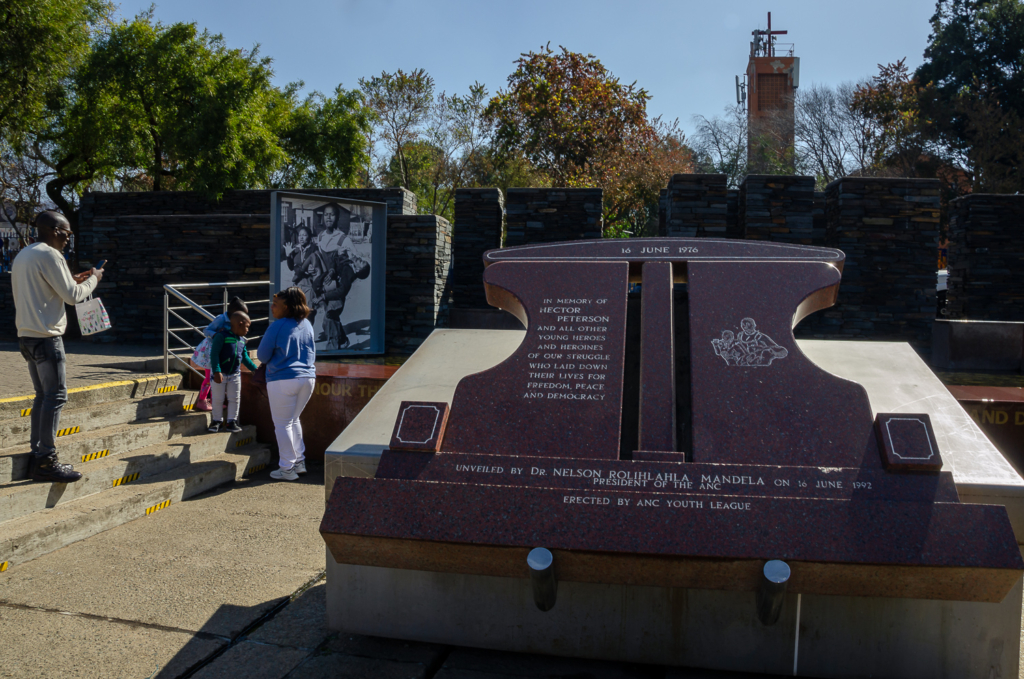
The photograph by Sam Nzima of the mortally wounded Pieterson being carried by another Soweto resident while his sister ran next to them quickly became an iconic image of the long and excruciatingly difficult battle to end apartheid. The memorial is a square with a tranquil waterfall, next to a museum.
Wandie’s Restaurant
The eponymous Wandie’s Restaurant is wildly popular in Soweto. Wandie took a moment to pose with us outside.
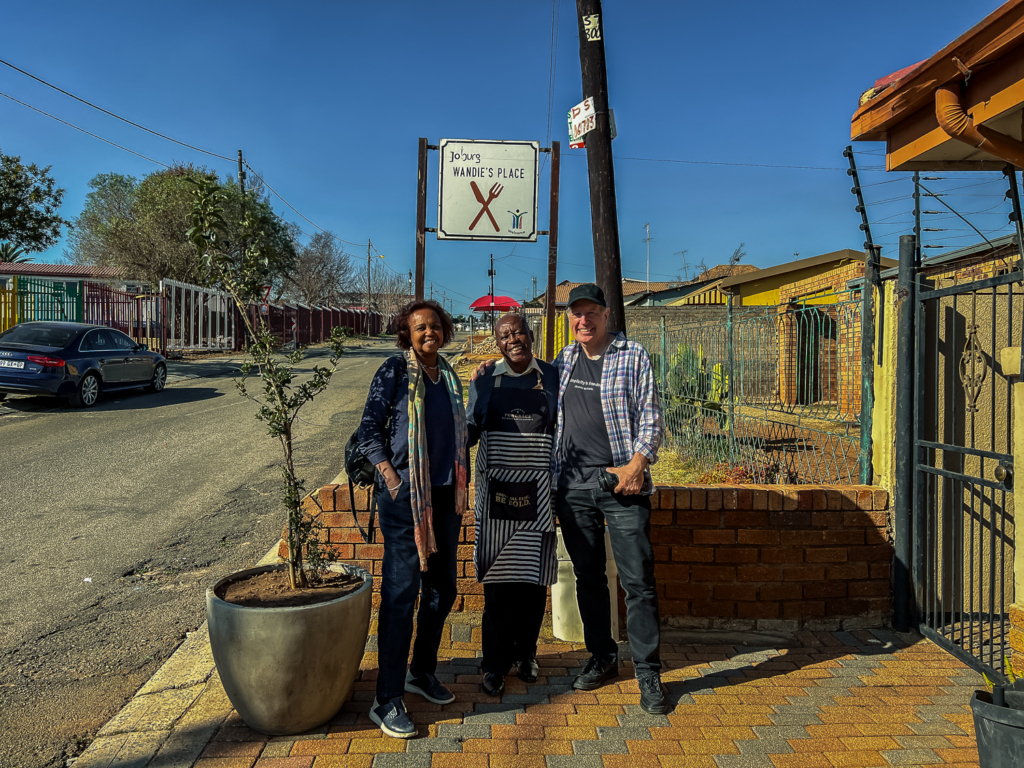
During the afternoon it’s filled mainly with tourists; the rest of the time locals frequent it. He survived the Covid shutdowns having no electricity in his area for 18 months (South Africa has many issues providing basic services). The offering is a buffet in cooking pans including tripe and spinach, rice and lentils and beef and chicken stews.
Kruger National Park
It took us over six hours to drive from Johannesburg to where we were staying in Kruger, with a stop for gas. We entered the park by crossing Crocodile Bridge Gate. Of note, Kruger is huge, about the size of New Jersey or Slovenia. In addition, there are private reserves outside of its borders.
Kruger Park has one of the greatest concentrations of large, terrestrial wildlife in the world. The only place comparable in my experience is the Serengeti / Masai Mara in Tanzania / Kenya.
If you can afford it, staying in a private lodge is fantastic. You can feast on wonderful food, sometimes see animals from the lodge (especially if they are near a waterhole) and, most importantly, have the option of two or three game drives/day and not stick to the road.
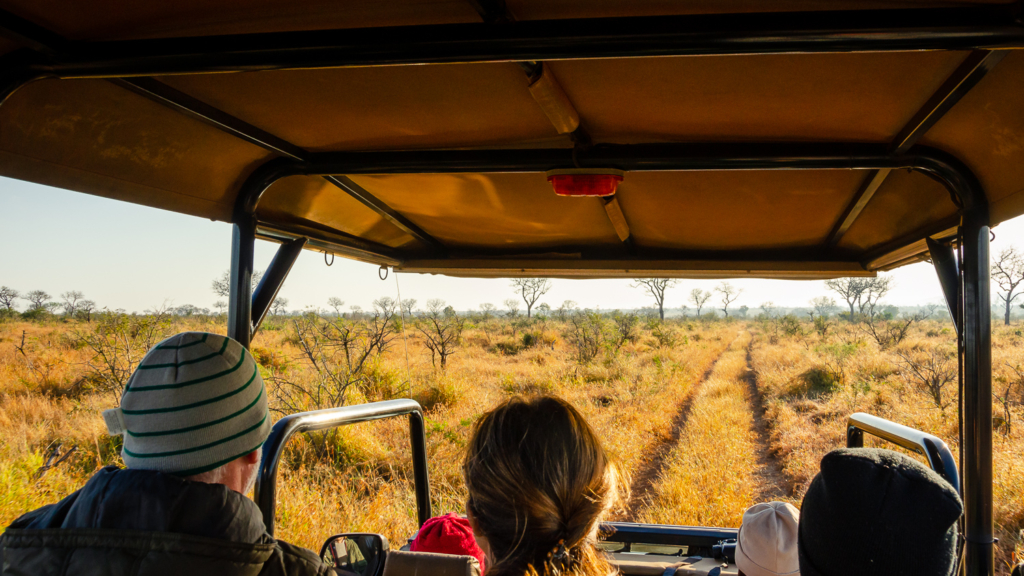
Private concessions in the park are typically rich in wildlife density and diversity. Certain areas of the park have greater concentrations of certain animals than others, which would be a factor in deciding on a lodge.
We stayed at Shishangeni by BON Hotels which didn’t disappoint. It was also convenient for our drive to Maputo, our next destination. We focused more on flora and animal behavior rather than a mad pursuit for the Big Five (elephant, lion, rhino, leopard and water buffalo), so named as they were initially considered the most dangerous to humans.
Luckily, most of the time we were on drives either by ourselves or with Mark from the UK who has been on over 20 safaris and was astoundingly knowledgeable. We were quite fortunate that Herold was our excellent game tracker.
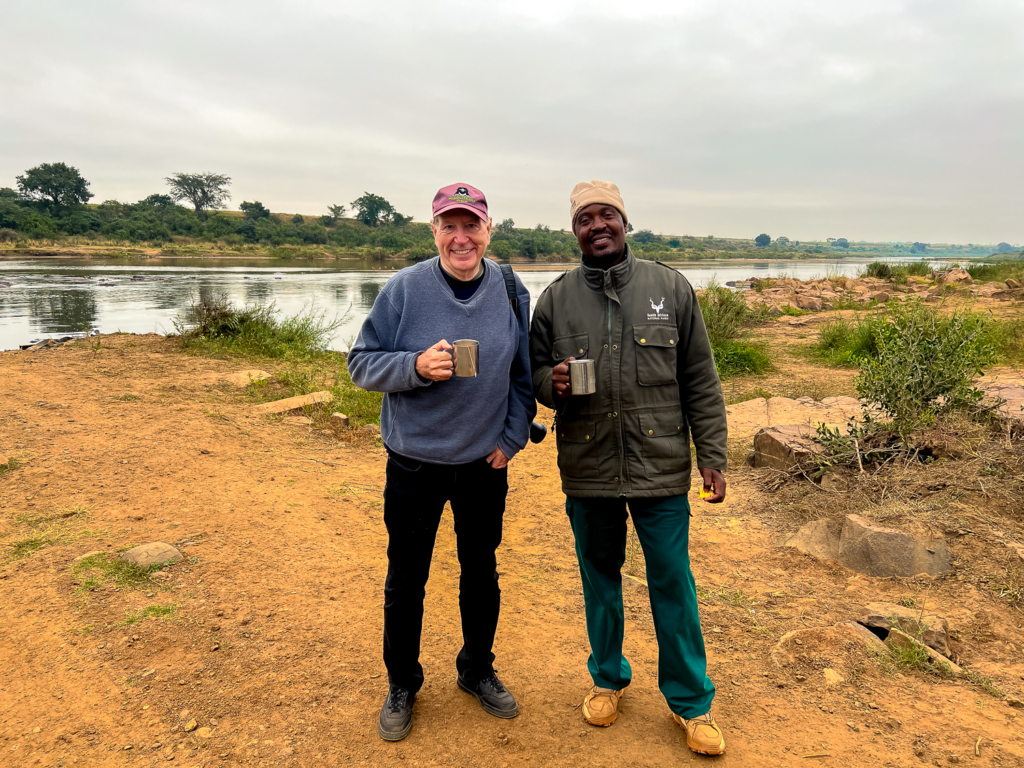
The main animal I wanted to see in Kruger was the leopard. I am fascinated by its strength, agility and sleekness. On our first drive, we saw this one just 15 minutes from the start and not another for the rest of our time there.
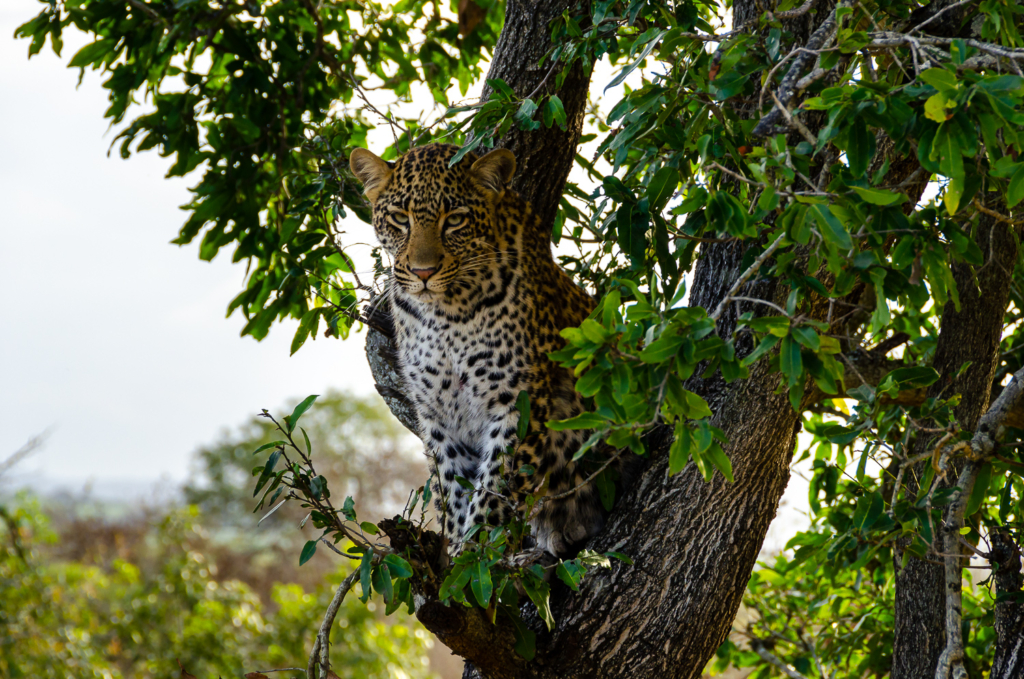
We had tremendously good luck in spotting lions. We happened upon a pride of 20 lions (7 female adults, the rest were offspring) and here are a few of them.
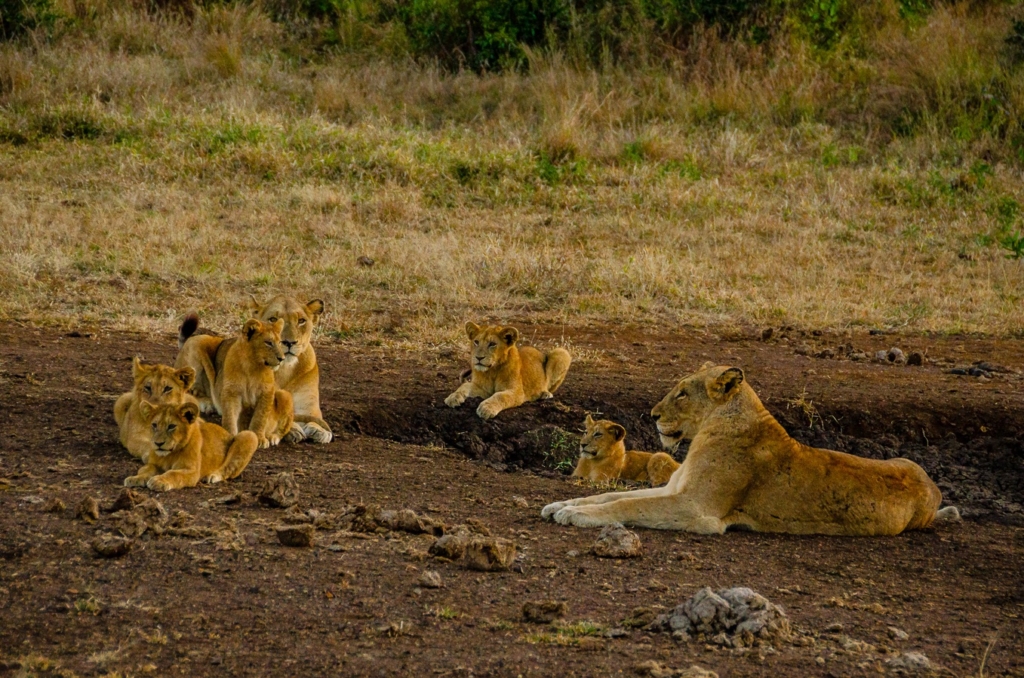
I wonder why there aren’t at least the Big Six animals to see, because whoever coined the term somehow forgot about the hippo which can sprint faster than any person. Hippos are responsible for an estimated 3,000 deaths per year in Africa.

White rhinos (they graze, black rhino browse) are fantastically strong but their horns are being cut to discourage poachers.

I never ceased to be mesmerized by the prehistoric-looking wildebeest.

A few of the other animals we saw were crocodiles…
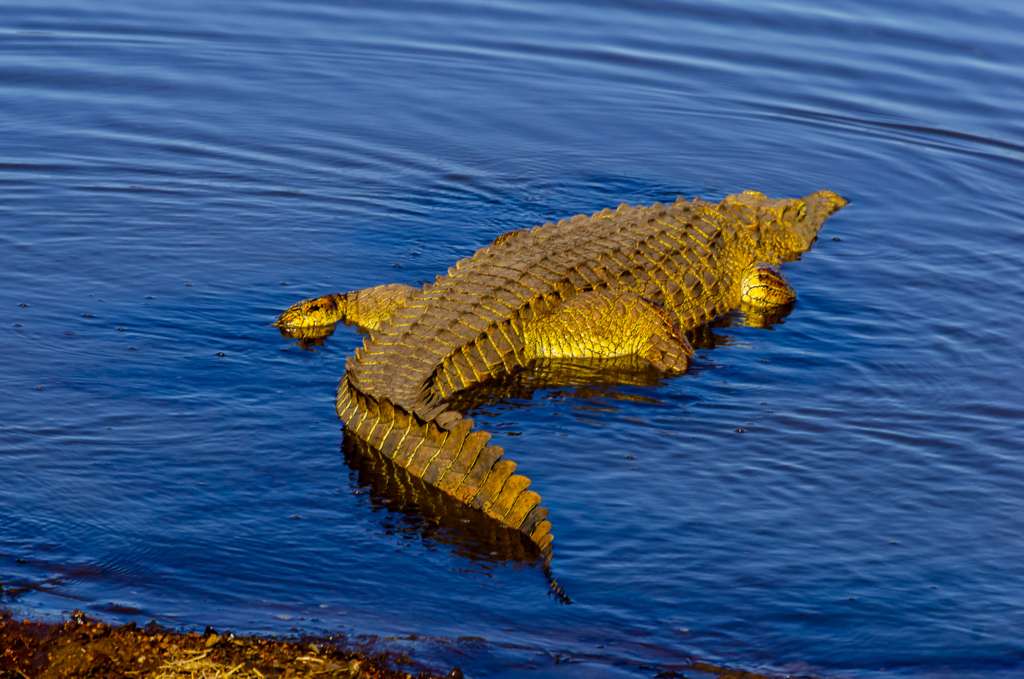
warthogs…

impalas…
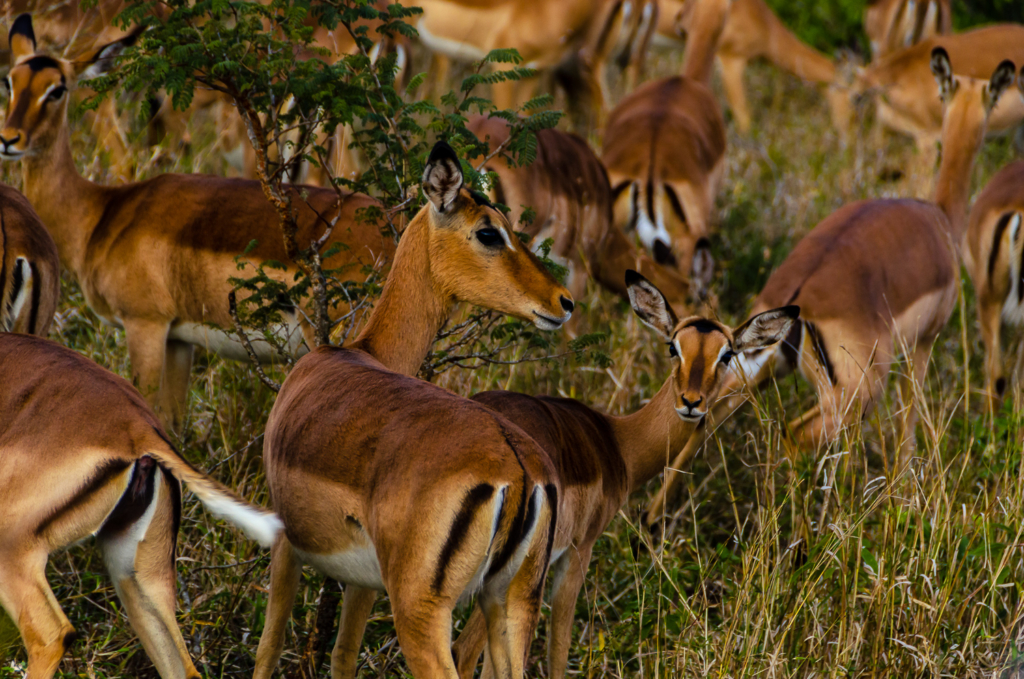
Zebras…
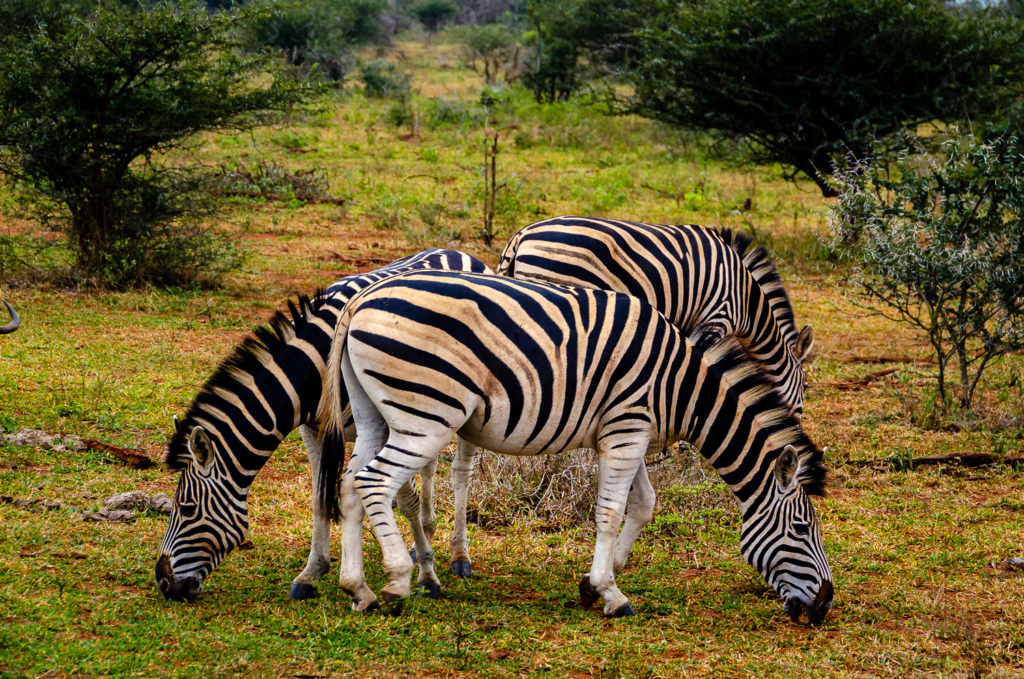
vervet monkeys…
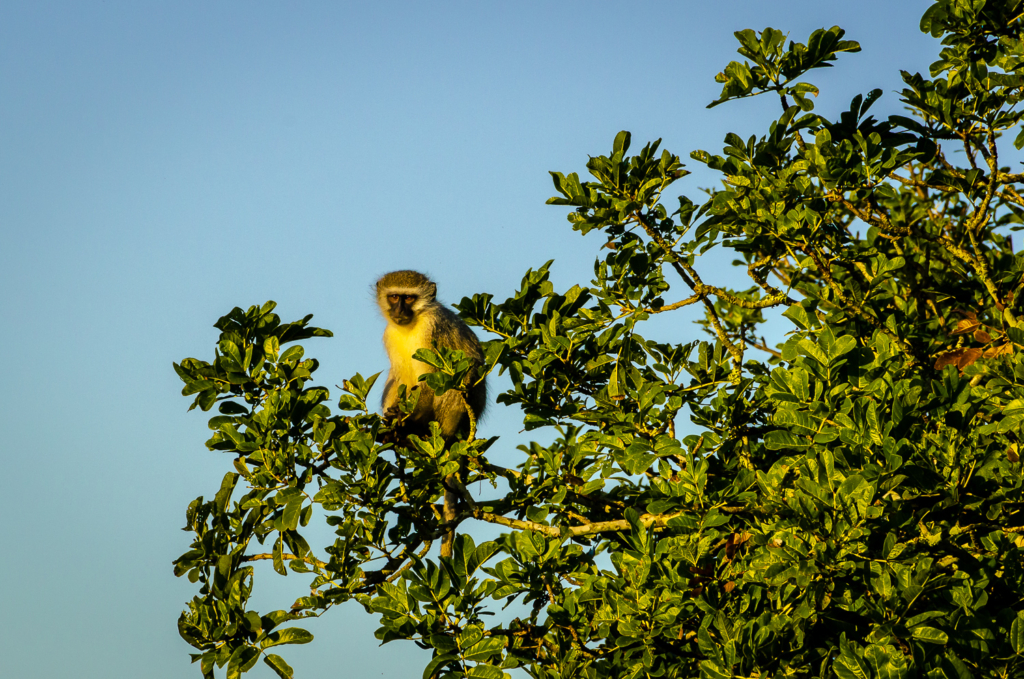
and a panoply of birds including the lilac-breasted roller.

The fever tree (so that’s where the psychedelic band in the late 60s got their name) often is missing its bark as elephants like to eat it.
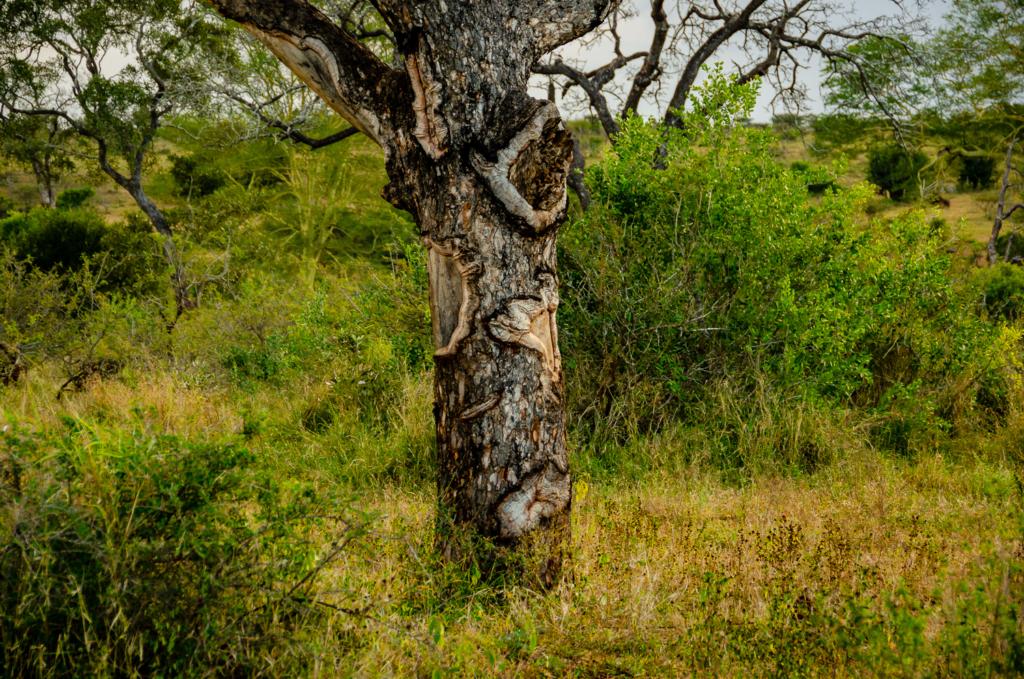
One part of the experience is being subsumed by the vast South African veldt and open sky.
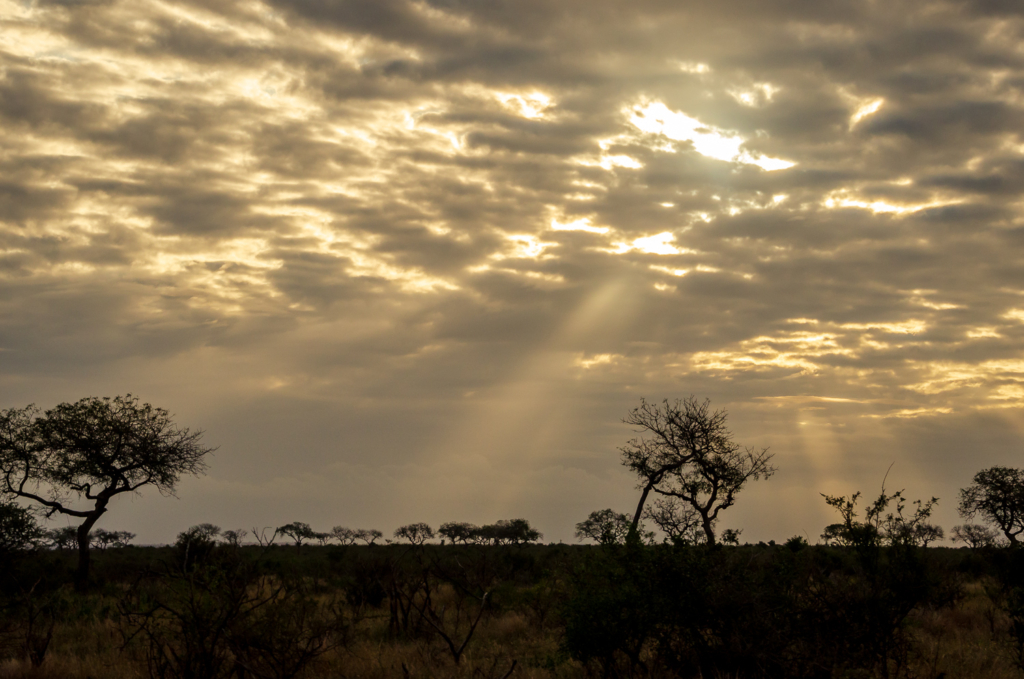
Maputo
Crossing the Border into Mozambique
Theoretically, we should have been able to drive from our lodge to Maputo in three hours, crossing the border at Lebombo, South Africa / Ressano Garcia, Mozambique. However, land crossing in Africa often is an adventure, especially with a car. In Mozambique, it took us 4 hours. When we arrived, they refused to recognize our Covid vaccination papers and made us take rapid tests (at a cost). We talked to others later who said they argued more than we did and avoided the test.
Then we found we didn’t get the exit stamp from South Africa and had to go back to their side of the border for it.
Then back in Mozambique, we went to the visa counter. The system was down and there was no manual workaround. While Khadija was taking it in good stride, a Dutch family had been there already for 5 hours.
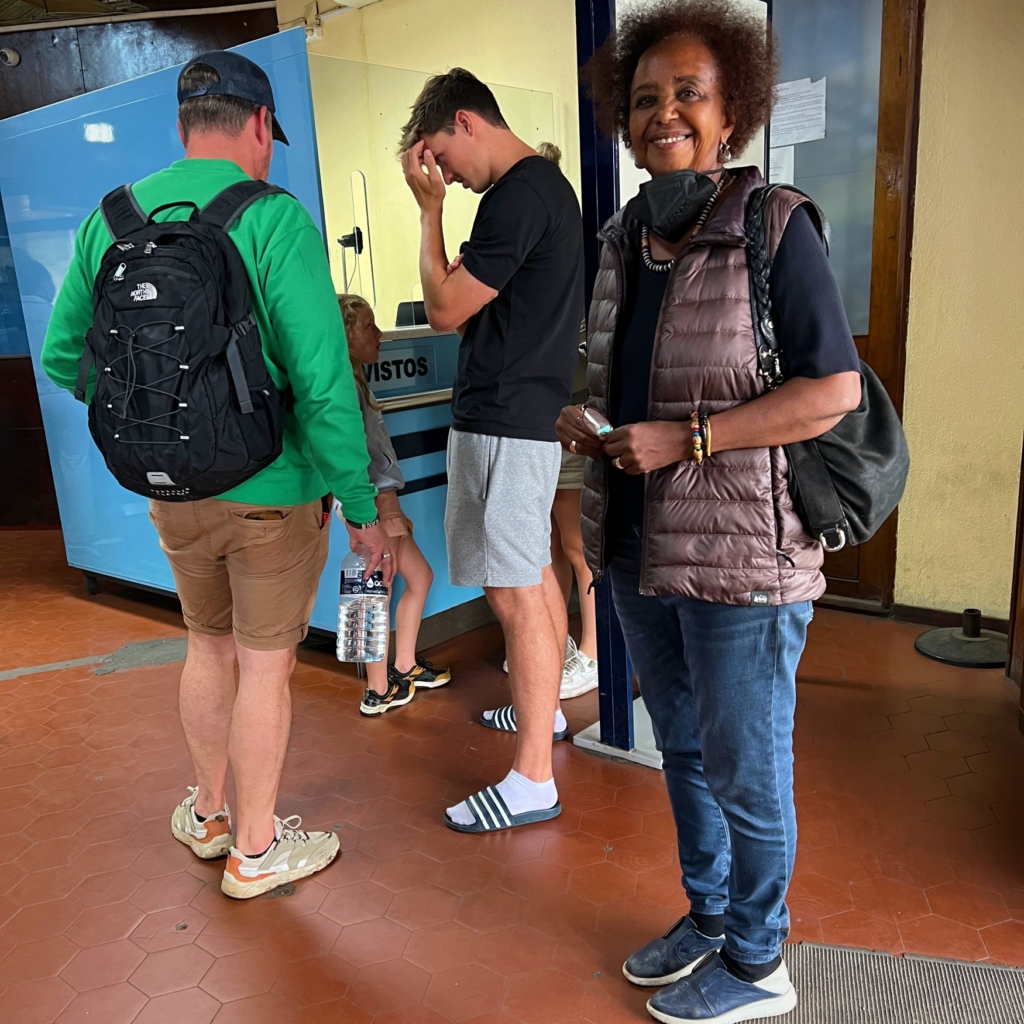
We were about to go back into South Africa and find another entry point which would have taken several hours. Fortunately, they soon fixed the problem apparently by reinstalling the software. It took a while longer as we were in a queue, but we finally got it and were able to pay by credit card.
Triumphally, we started to drive away but were stopped and told we needed to pay a tax on the car registration. So, we proceeded to the building and departed with more of our money.
Finally ready to dash to Maputo, we were stopped again and told we had to buy some type of insurance for the car. We paid while in the car and finally were able to enter the country.
There were literally miles of cargo trucks waiting to cross the border and taking up several lanes of the highway. It took over a half hour to pass them.
Background Information on Maputo and Mozambique
Maputo is the capital of Mozambique and is situated on the Indian Ocean at the southern tip of the country. Its name is derived from the Portuguese trader who first explored the region in 1544. It became a city in 1887, then the capital of Portuguese East Africa in 1907.
Following independence in 1975, the Marxist government nationalized many parts of the economy and battled nationalist anti-Communist forces. The warfare, directly and indirectly, displaced and killed millions of people. It officially ended in 1992 and there’s technically still no private ownership of land in Mozambique. Land and natural resources are the property of the State, but private persons have the right to use it. The legal system recognizes and protects property rights for buildings, movable property, and businesses.
Mozambique is now a multiparty democracy with authoritarian leadership under the Frelimo party. Economically it was growing around 8% / year before a massive scandal was discovered in 2016 where US$500 million disappeared. Despite this setback, the country has strong potential in offshore fossil fuels and agriculture.
Reflecting the Communist leanings of Mozambique after independence, many streets are named after Communist, Socialist and Liberation leaders of the 20th century including this intersection of Lenin (Russia) and Mao (China).
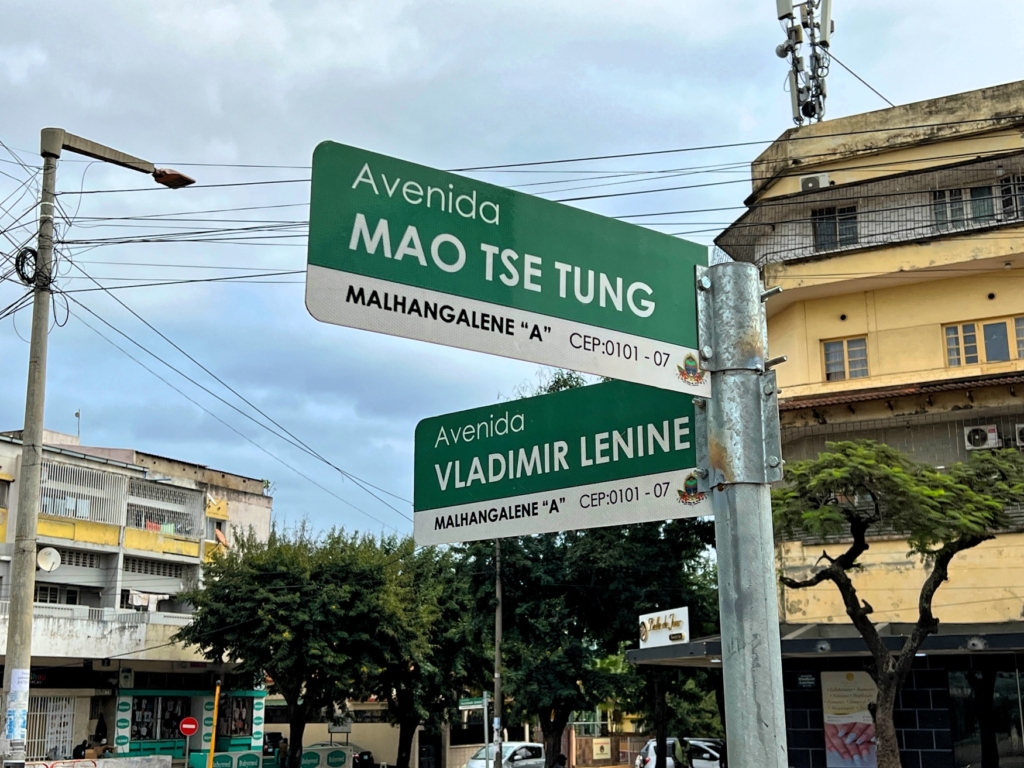
Walking Around Maputo
We spent almost all our time walking around the tip of Maputo, west of Maputo Bay and northeast of the Estuário do Espírito Santo (Holy Spirit Estuary) where four rivers (Tembe, Umbeluzi, Matola and Infulene) end. We strolled by interesting architecture, beautiful parks, historical monuments and enticing restaurants.

It was refreshing to walk around this city where safety is not such a concern as in Johannesburg.
Julius Nyerere and Marginal Avenues
We splurged a bit and stayed at the fabulous Polona Serena Hotel built in 1922 in the then-fashionable Palace Style. It has amazing woodwork, tiles and mosaics throughout. As part of the Portuguese empire, the hotel made the ideal neutral meeting place for spies and secret agents from both the Allied and Axis forces during WWII. In 2002, it was bought by the Aga Khan Foundation for Economic Development and is now part of his Serena Group.
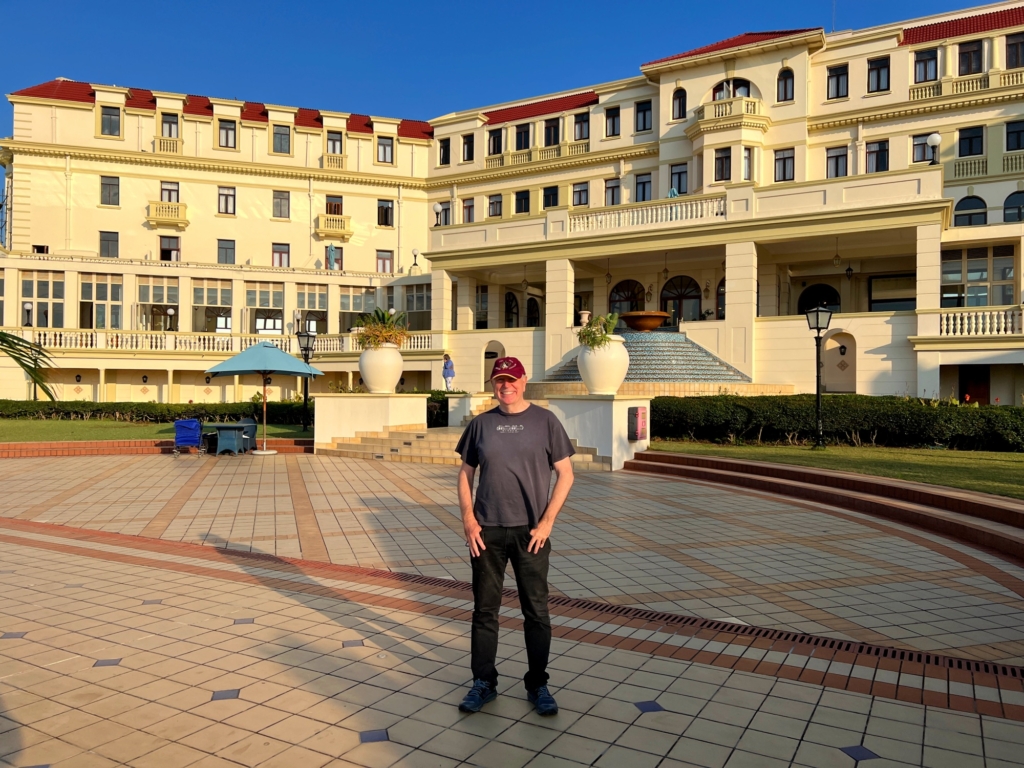
The hotel is on Julius Nyerere Avenue, where many countries have embassies. Parallel to this is Marginal Avenue, which follows the Indian Ocean. Behind the Polona Serena, the wide road has an extended stretch of mosaics.
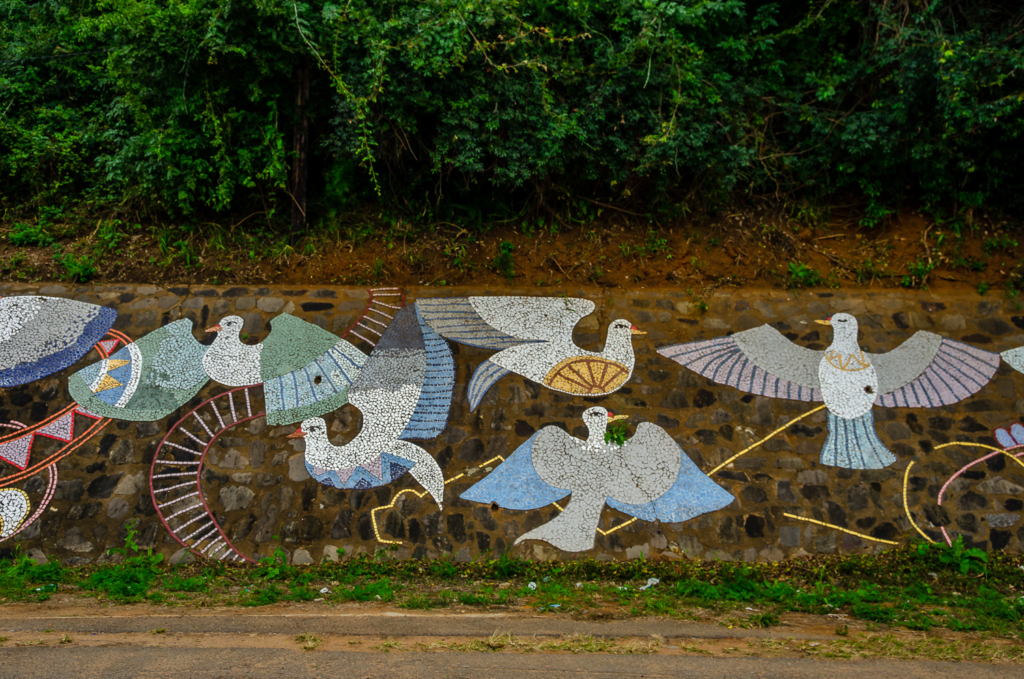
Parque dos Continuadores
This park (also known as FEIMA), at the corner of Julius Nyerere and Mao Tse-Tung, is a marvelous place to buy local art and souvenirs. There are many vendors with an ample selection and prices are reasonable, especially after you bargain.

Architectural Walking Tour
We arranged a walking tour through Maputo On Foot with Walter, an architect on the left in the photo, and the company owner, Daniel.
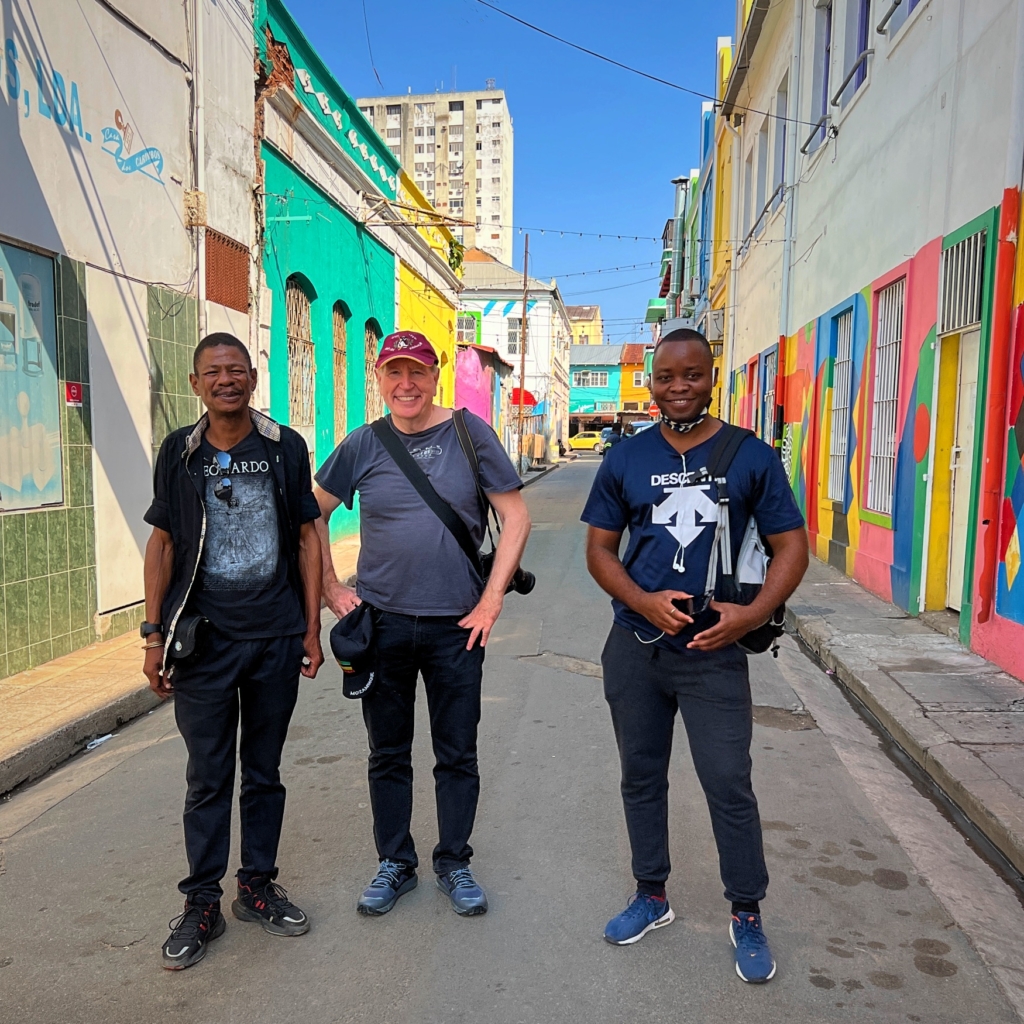
I highly recommend them, and the rest of this section is from the tour.
Maputo Cathedral
The Cathedral is a prominent landmark, but the inside decorations and embellishments are restrained and remind me of an Anglican Church.

After independence, the government nationalized church assets and stopped all subsidies. However, Mozambique’s constitution guarantees the freedom to practice one’s faith. The relationship between the Catholic Church gradually thawed and over the years many buildings have been returned. There are over 2,000 Catholic parishes in the country.
The visit of John Paul II in 1988 was a celebrated occasion and there’s a memorial of the event off the nave.
Samora Machel Statue
This is a giant reproduction of a statue of the first president Samora Machel, who was killed in a mysterious airplane crash after the first decade of independence. The statues are all over the country in various sizes.
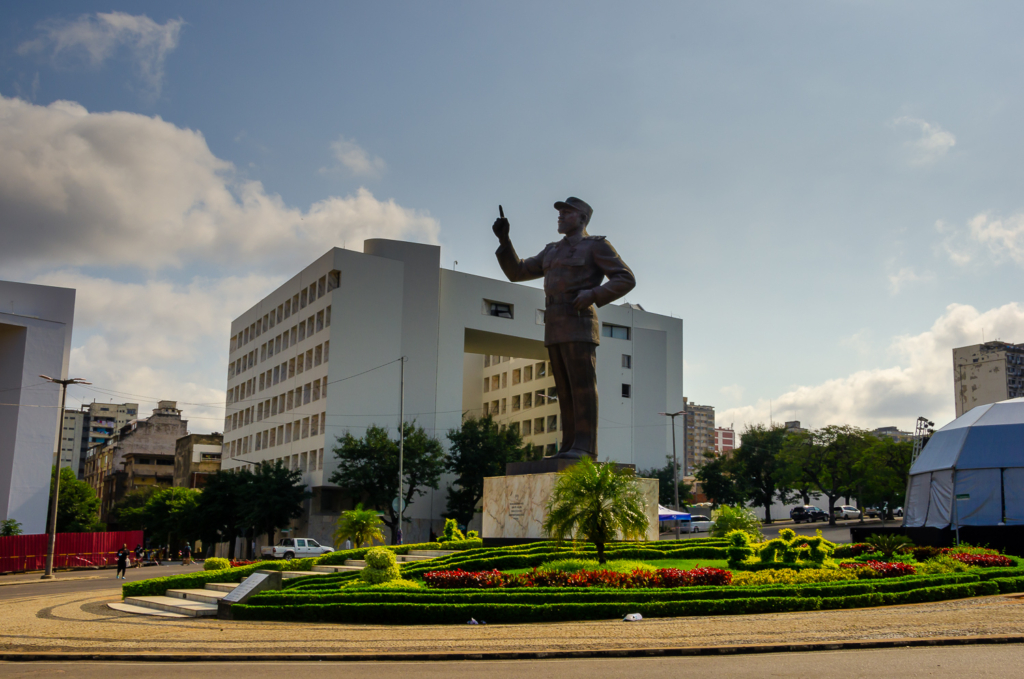
Machel’s wife, Josina Machel, later married Nelson Mandela when he was 80 years old and became the only woman to be First Lady of two countries.
Tunduru Gardens
These botanical gardens are a good place to take a shady rest under jacarandas, palm trees and nesting birds. The park was designed by Englishman Thomas Honney in the late 1800s. This is the top venue in Maputo for weddings.
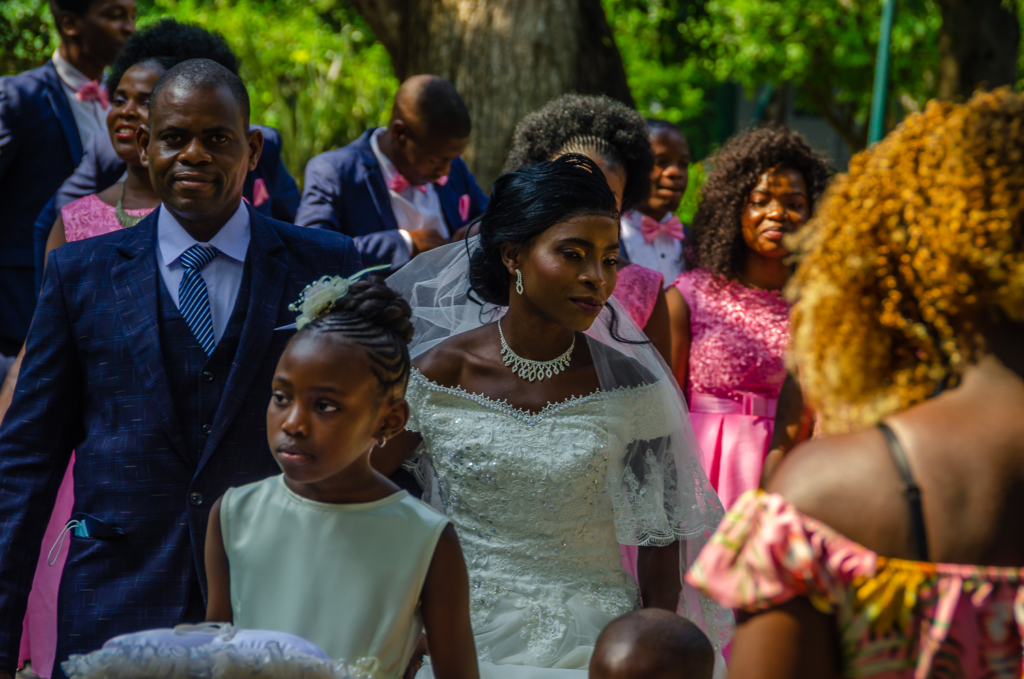
Iron House
The improbable structure, designed by Gustave Eiffel, was prefabricated in Belgium in 1892 and brought to Mozambique. However, it was uninhabitable in the hot and humid climate.
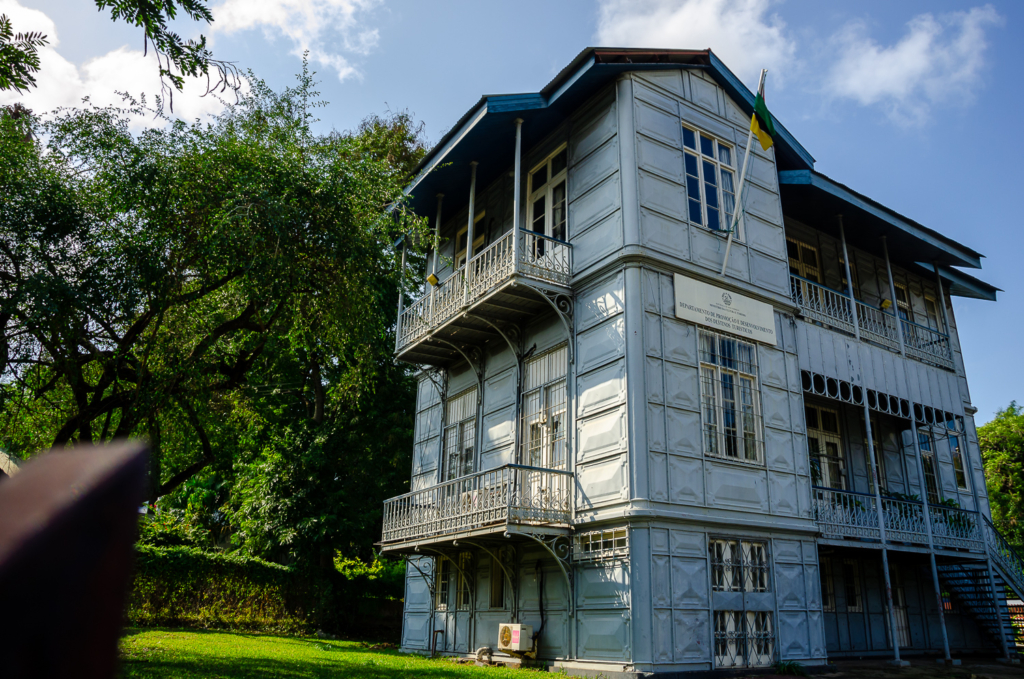
Art Deco and Bauhaus
Maputo is full of scattered Art Deco buildings and one of the best examples is the cathedral mentioned above, an unusual design for a church. The city has several cinemas in this style, though some no longer show films but are performance spaces, including Gil Vicente across the street from Tunduru Gardens. The building opened in 1933 with its streamlined and geometric exterior and over 1,300 seats. Gil Vicente was a famous Portuguese playwright who acted in and directed his plays.
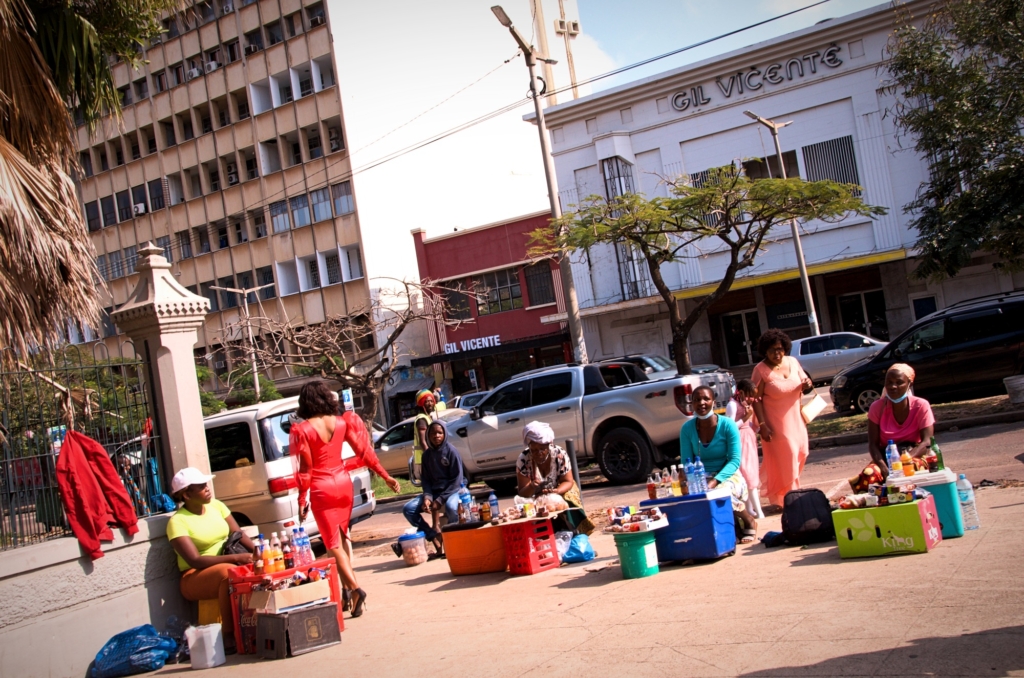
The city may have even more of utilitarian Bauhaus buildings than Art Deco ones. Here’s a good example of the simple but harmonious design, though the subsequently-applied colorful paint is not typical.

The reason for both contemporaneous styles appearing together in Maputo is that then Portuguese dictator Salazar didn’t like the non-classical styles. So Portuguese architects had to go to the colonies to design in these vernaculars.
There are also many other architectural styles in the city, sometimes mixed into one building. The building stock needs substantial renovation and new paint.
Bring Back Maputo and Rua d’Arte
Maputo has a small section, including “Art Street”, that has a Miami Beach look with a lot of outdoor murals.

This is a relatively new facelift guided by the “Bring Back Maputo” initiative. Several buildings are being given a cheerful and colorful image.
Central Market
A place not to miss in any city is the central market and Maputo is no exception.
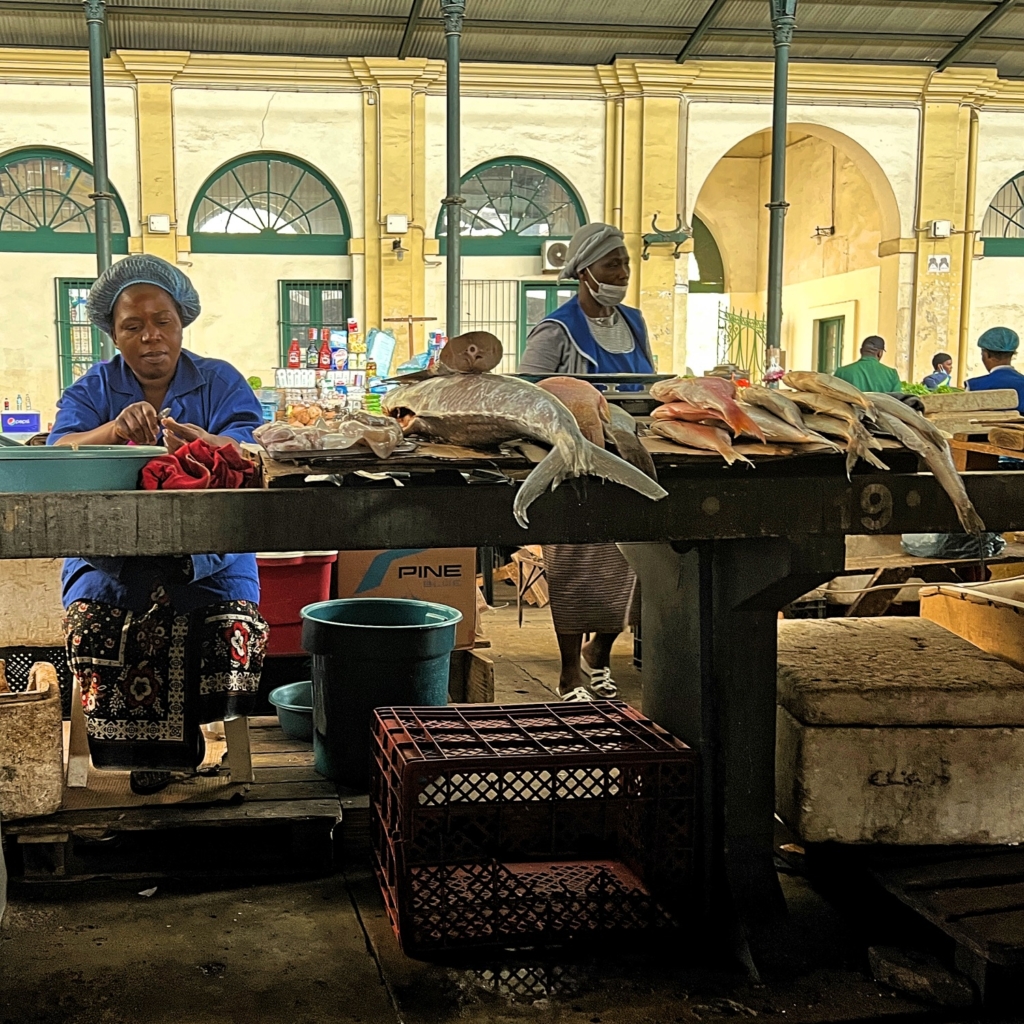
Maputo Railway Station
The Beaux-Arts Central Railway Station was completed in 1916. Today it only provides services for weekday commuters. It’s on par with great train stations around the world, which the station honored in a display while we were there.

Mailbox
This is an old mailbox with the image of, I presume, Samora Machel, the first president. This was next to the domain of working girls who definitely did not want any pictures taken of them.
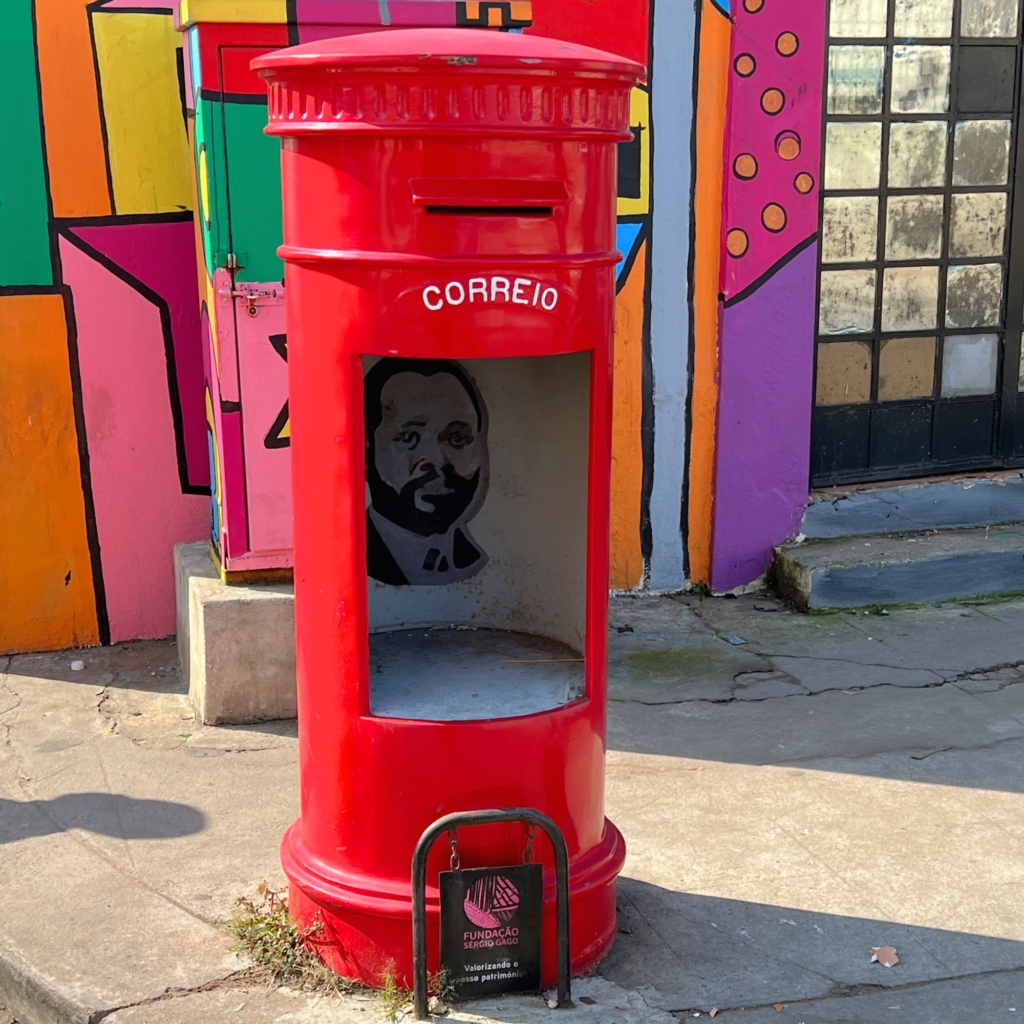
Fortress of Maputo
Perhaps the most obvious reminder of Maputo’s colonial past is the Fortress of Our Lady of the Conception or the Maputo Fortress. It was initially built in the 1780s and rebuilt many times. It’s now a museum with items in the interior yard and rooms in the wall.

Final Thoughts
One of our priorities was to listen to live music in Maputo, as the African Portuguese colonies are renowned for it and we heard great songs on the car radio. Well, we tried but were thwarted at every attempt, as explained in this video.
So, we just have to come back to Maputo and Mozambique to make sure we fulfill this wish!
Be sure to read the continuation of this great African roadtrip: South African Road Trip – Part 2: Eswatini, Durban, Lesotho and Clarens.

